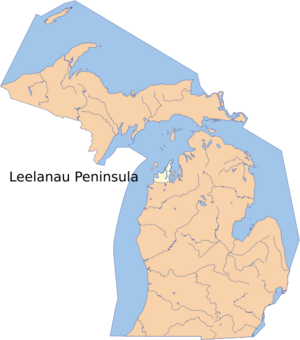Leelanau Peninsula facts for kids
The Leelanau Peninsula is a cool piece of land in Michigan, shaped like a finger sticking out into Lake Michigan. It's about 30 miles (48 km) long. The whole peninsula is part of Leelanau County. People often call it the "little finger" of Michigan's Lower Peninsula, which looks like a mitten!
Contents
Exploring the Leelanau Peninsula
The Leelanau Peninsula is full of interesting places. On its west side, you'll find Sleeping Bear Dunes National Lakeshore. This area has huge sand dunes and beautiful beaches. At the very northern tip, there's Leelanau State Park and the old Grand Traverse Light lighthouse.
On the east side of the peninsula is Grand Traverse Bay. The city of Traverse City sits at the base of the peninsula on this bay. To the northwest, you can see North and South Manitou Islands.
Nature and Farming
A long lake called Lake Leelanau runs right through the middle of the peninsula. It's about 13 miles (21 km) long and covers a large area.
The peninsula has a special microclimate. This means the weather here is milder than places further inland. This is because of the steep land and the large lakes nearby. This mild weather is great for farming!
The Leelanau Peninsula is famous for its fruit. Farmers grow lots of apples and tart cherries here. Since 1925, Traverse City has even held annual festivals to celebrate the cherry harvest. The area is also known for its many wineries. It's a special wine region called the Leelanau Peninsula AVA.
Native American Heritage
The Grand Traverse Band of Ottawa & Chippewa are a group of Native Americans who live on the peninsula. Their community is around Peshawbestown, Michigan. Their ancestors, who spoke the Algonquian language, lived in this area long before Europeans arrived.
Towns and Villages
Many communities are located on the Leelanau Peninsula, including:
- Northport Point
- Northport, Michigan
- Omena, Michigan
- Leland, Michigan
- Peshawbestown, Michigan
- Suttons Bay, Michigan
- Lake Leelanau, Michigan
- Glen Arbor
- Glen Haven, Michigan
- Empire, Michigan
- Greilickville, Michigan
- Maple City, Michigan
- Cedar
History of the Peninsula
The Native Americans who first lived here called this land "ke-ski-bi-ag." This name means "narrow body of water."
The name "Leelanau" was once thought to be a Native American word meaning "delight of life." However, it was probably made up by Henry Rowe Schoolcraft or his wife, Jane Johnston Schoolcraft. Henry was a United States Indian agent in the early 1800s. He used the name Leelinau for a character in his stories.
Jane Johnston Schoolcraft was very important. She was the daughter of a fur trader and an Ojibwe chief's daughter. She learned a lot about the Ojibwe people through her family. Jane first used Leelinau as a pen name for her own writings. She wrote in both Ojibwe and English.
Even though her writings were not officially published during her lifetime, Jane Johnston Schoolcraft is now recognized as a very important writer. She is known as the first Native American literary writer. She was also the first known Native American woman writer and poet. In 2008, she was honored by being added to the Michigan Women's Hall of Fame.
Fun Places to Visit
Images for kids
-
The Leelanau Peninsula is just to the right of the center as seen from the Cupola of the International Space Station. North is oriented towards the upper left; taken on March 11, 2012.



